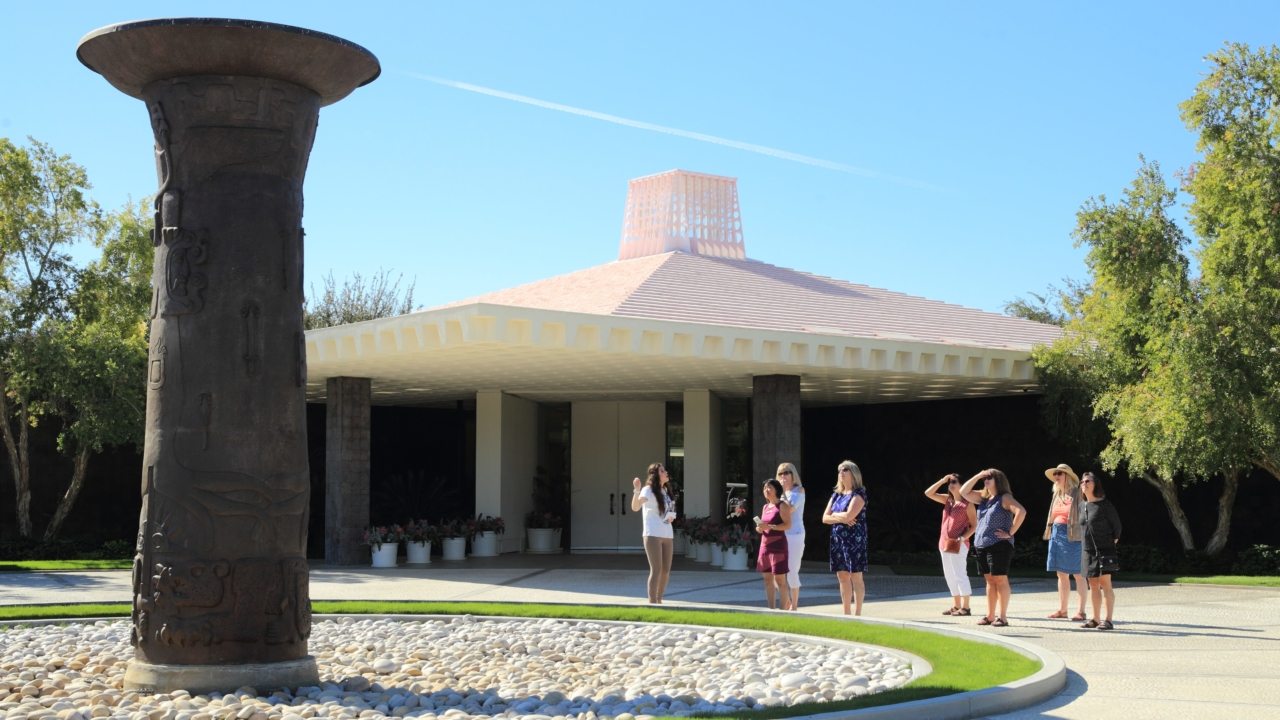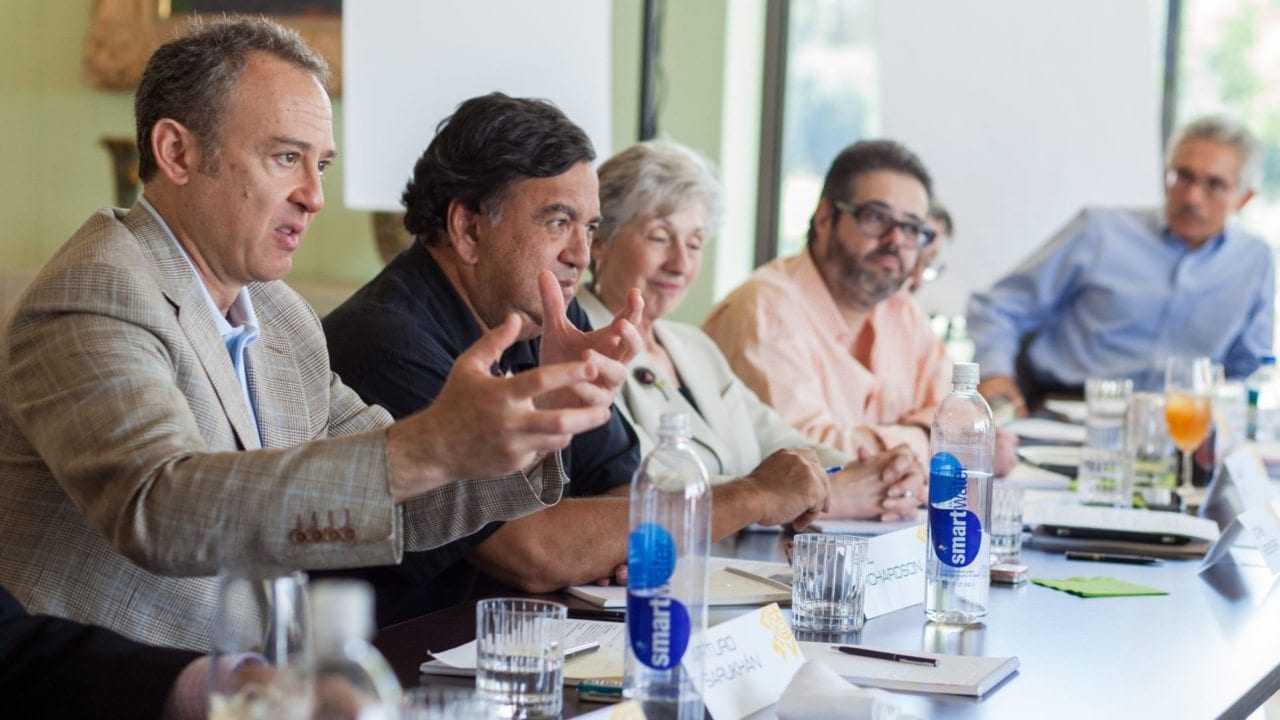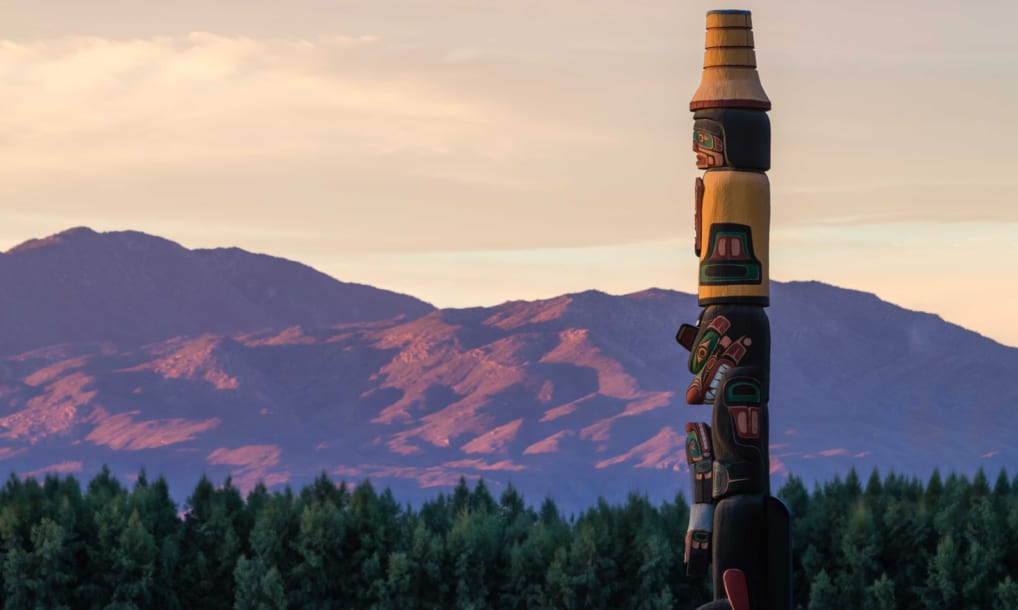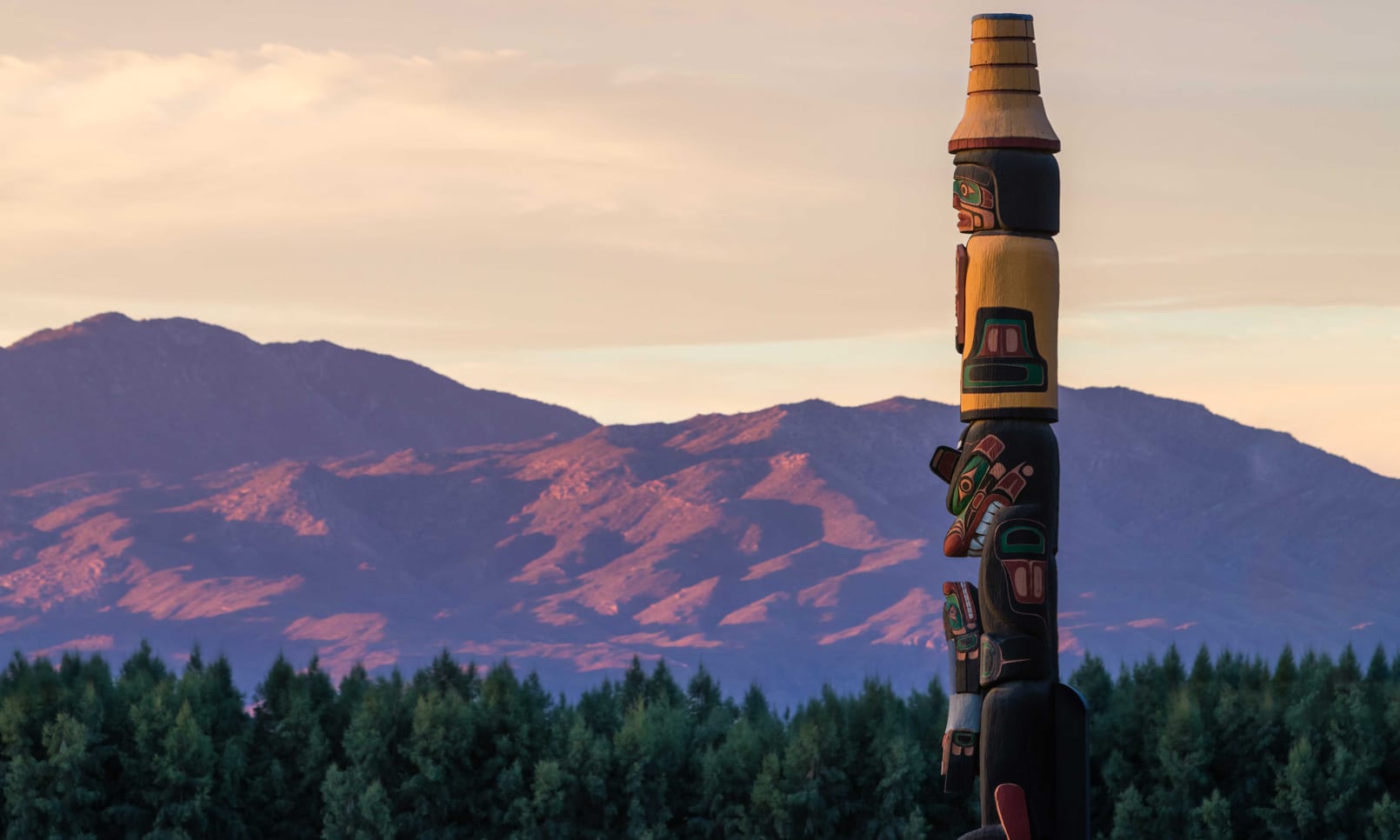Make Your Own Totem Pole Craft
What is a totem pole?
A totem is an emblem of a family or clan. This emblem can feature a natural object, an animal or a spirit being.
A totem pole is a monument of a single log of red cedar that is carved by First Nations peoples of the Pacific Northwest Coast. A pole includes an arrangement of several totems.
What is it used for?
A totem pole can be used for different purposes: to welcome visitors, as a memorial for important members of the tribe, as a tomb or headstone, to celebrate a special occasion, or as a supporting column inside houses.
What figures are displayed on a totem pole?
A totem pole typically features symbolic and stylized human, animal, and supernatural forms. They are visual representations of family stories and ancestry. Families acquire the rights to display specific figures, or crests, over many generations. These crests can be acquired through supernatural encounters that ancestors had and were handed down to their descendants, through marriage, or in a potlatch. A potlatch was a ceremony to mark important life events, including the new use of a family crest.
Some common figures are:
Human figures—chief
Sky elements—sun, moon
Animals of the forest and mountains—bear, wolf
Sea beings—seal, whale, salmon
Sky beings—eagle, raven, wolf
Supernatural—Thunderbird, Sisiutl (double-headed serpent)
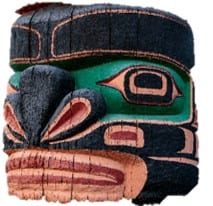
Sisiutl, a double-headed serpent, one of the many crests of the Hunt family.
Henry Hunt totem pole at Sunnylands. (Click to expand)
How are they designed?
Figures are characterized by two elements:
1. Formline
A combination of thin and thick lines that help to divide figures and structure the design.
2. Basic colors
Black—Used for the formline
Red—Adds detail
Blue-green—Used as a tertiary to help distinguish between multiple figures.
However, styles can vary by clan, and other colors like brown, white, green, and yellow are sometimes used.
All figures face the center front, because this is the point of visual interest of the totem.
Make your own
If you were making a totem pole to tell a story about your family, what figures would you display on it?
Think about some of the qualities or features of the family members you want to include. Is there an animal that embodies those qualities? Or can you invent a special character? How would you represent them?
All you need:
Cardboard tube, markers, colored paper, scissors, glue, and other recycled materials.
Here are some examples of standard representations you can use as inspiration:
Human figures
– Compressed or seated position
– Head, features, torso, arms and legs, represented
– Torso upright, arms fall straight
– Face with eyebrows, eyes, nose, and mouth
– With or without adornment (cloak, hat, ring)
Birds
– Seated position, facing center front
– Wings and beaks are essential
– Wings either forced or extended
– Feathers indicated by texture and contrasting colors
Instructions
1. Think about how many family members you want to include in your totem pole. This will help you determine the proportions of each character and how your totem pole will be divided.
2. Use the markers to draw the main features of your character on a piece of paper. You can use colored paper or add color later using markers.
3. Cut your figures and glue them to the totem pole.
Glossary of some of the terms used in this activity
Clan—A large family, a group of people of common descent, or a group of close-knit, interrelated families.
Crest—An emblem or formal design used as a symbol to represent a family, town, group, or organization. For many tribes of the Pacific Northwest Coast, the crest emblem represents an entity with which the clan claims a significant relationship.
Potlatch—A ceremony to commemorate important events in the host’s life such as marriage, the birth and naming of a child, mourning the dead, a new social rank, and the transfer of rights. These ceremonies often included many guests, speechmaking, feasting, gift giving, and dance performances.
Tertiary—Third in order. In art, it refers to the colors created by mixing the primary and secondary colors in various ways. Primary colors are red, blue, and yellow. Secondary colors are green, orange, and purple.
Resources
Reach for the Sky: Tradition + Inspiration—Access the catalog of the exhibition, photos, and a coloring page of a traditional Northwest Coast Symbol. https://sunnylands.org/on-view-reach-for-the-sky/
Book: If You Lived With The Indians Of The Northwest Coast by Anne Kamma.
Book: Kwakiutl Art by Audrey Hawthorn
Here are some links to help you explore more about this topic
Biographies of members of the Hunt family:
Henry Hunt—https://en.wikipedia.org/wiki/Henry_Hunt_(artist)
Stanley C. Hunt—https://en.wikipedia.org/wiki/Stanley_C._Hunt
Museums that care for collections that include art and artifacts from the Pacific Northwest Coast
The Royal BC Museum in Victoria, British Columbia—https://www.royalbcmuseum.bc.ca/
National Museum of the American Indian in Washington, D.C.—https://americanindian.si.edu/
Burke Museum in Seattle, Washington—https://www.burkemuseum.org/
Click below for the downloadable PDF
¿Qué es un tótem?
Un tótem es un emblema de una familia o tribu. Este emblema puede incluir un objeto natural, un animal o un espíritu.
La palabra tótem también se utiliza para referirse al monumento producido de un solo tronco de cedro rojo tallado por los pueblos de las Naciones Originarias de la Costa noroeste del Pacífico.
¿Para qué se utiliza?
Un tótem se puede usar para diferentes propósitos: para dar la bienvenida a visitantes, como monumento conmemorativo de miembros importantes de la tribu, como una tumba o lápida, para celebrar una ocasión especial, o como columna de soporte dentro de las casas.
¿Qué figuras se muestran en un tótem?
Un tótem generalmente presenta formas simbólicas y estilizadas de humanos, animales y figuras sobrenaturales. Son representaciones visuales de historias familiares y de linaje. Las familias adquieren los derechos para exhibir figuras especificas, o crestas, durante muchas generaciones. Estas crestas se adquieren a través de encuentros sobrenaturales que tuvieron los ancestros y los transmitieron a sus descendientes, a través del matrimonio o en un potlatch. Un potlatch es una ceremonia para marcar eventos importantes, incluyendo el nuevo uso de una cresta familiar.
Algunas figuras communes son:
Figuras humanas—jefe
Elementos celestiasles—sol, luna
Animales del bosque y la montaña —oso, lobo
Seres marinos—foca, ballena, salmón
Seres celestials—águila, cuervo, búho
Sobrenaturales—Thunderbird, Sisiutl (serpiente de doble cabeza)

Sisiutl, serpiente con doble cabeza, una de muchas crestas de la familia Hunt.
Tótem de Henry Hunt en Sunnylands (Haga clic para ampliar)
¿Cómo están diseñados?
Las figuras se caracterizan por dos elementos:
1. Formline
Una combinación de líneas finas y gruesas que ayudan a dividir figuras y estructurar el diseño.
2. Colores básicos
Negro—Usado para el formline
Rojo—Agrega detalles
Azul-verdoso—Usado como terciario para distinguir entre múltiples figuras
Sin embargo, los estilos pueden variar según el clan y a veces se usan otros colores como el marrón, blanco, verde y amarillo.
Todas las figuras miran hacia el frente central, porque este es el punto de mayor interés visual del tótem.
Crea tu propio tótem
Si fueras a hacer un tótem para contar una historia sobre tu familia, ¿qué figuras mostrarías en él?
Piensa en algunas de las cualidades o rasgos de los miembros de tu familia que deseas representar. ¿Hay algún animal que encarne esas cualidades? ¿O puedes inventar un personaje especial? ¿Cómo los representarías?
Solo necesitas:
Tubo de cartón, marcadores, papel de colores, tijeras, pegamento y otros materiales reciclados.
Algunos ejemplos de representaciones comunes que puedes usar como inspiración:
Figuras humanas
– Posición comprimida o sentada
– Cabeza, rasgos, torso, brazos y piernas representadas
– Torso erguido, brazos caídos
– Cara con cejas, ojos, nariz y boca
– Con o sin adorno (capa, gorro, anillo)
Aves
– Posición sentada, mirando hacia el frente
– Picos y alas son esenciales
– Alas dobladas o extendidas
– Plumas definidas por textura y colores contrastantes
Instrucciones
1. Piensa en cuantos miembros de tu familia quieres incluir en tu tótem. Esto te ayudará a determinar las proporciones de cada personaje y cómo se dividirá tu tótem.
2. Utiliza los marcadores para dibujar las características principales de tu personaje en una hoja de papel. Puedes usar papel de colores o agregar color más tarde usando los marcadores.
3. Corta tus figuras y pégalas al tótem.
Glosario de algunos de los términos utilizados en esta actividad
Clan—Una familia numerosa, un grupo de personas de ascendencia común o un grupo de familias muy unidas e interrelacionadas.
Cresta—Un emblema o diseño formal utilizado como símbolo para representar una familia, pueblo, grupo u organización. Para muchas tribus de la costa noroeste del Pacífico, la cresta representa una entidad con la cual el clan afirma tener una relación significativa.
Potlatch—Una ceremonia para conmemorar eventos importantes en la vida del anfitrión, tales como un matrimonio, el nacimiento y nombramiento de un niño, el duelo de un fallecido, un nuevo rango social y la transferencia de derechos. Estas ceremonias a menudo incluían muchos invitados, discursos, banquetes, regalos y presentaciones de baile.
Terciario—Tercero en orden. En el arte, se refiere a los colores creados al mezclar los colores primarios y secundarios de varias maneras. Los colores primarios son rojo, azul y amarillo. Los colores secundarios son verde, anaranjado y morado.
Recursos
Alcanzando el cielo: Tradición + inspiración—Accede el catálogo de la exhibición, fotos y una página de colorear de un símbolo tradicional del la costa Noroeste.
http://sunnylands.org/on-view-reach-for-the-sky/
Libro: If You Lived With The Indians Of The Northwest Coast por Anne Kamma.
Libro: Kwakiutl Art por Audrey Hawthorn
A continuación algunos enlaces para ayudarte a explorar más sobre este tema
Biografías de miembros de la familia Hunt:
Henry Hunt—https://en.wikipedia.org/wiki/Henry_Hunt_(artist)
Stanley C. Hunt—https://en.wikipedia.org/wiki/Stanley_C._Hunt
Museos que custodian colecciones que incluyen arte y artefactos de la costa Noroeste del Pacífico
Museo Real de la Columbia Británica, Victoria—https://www.royalbcmuseum.bc.ca/
Museo Nacional del Indio Americano en Washington, D.C.—https://americanindian.si.edu/
Museo Burke en Seattle, Washington—https://www.burkemuseum.org/
Haga clic a continuación para acceder el PDF descargable

